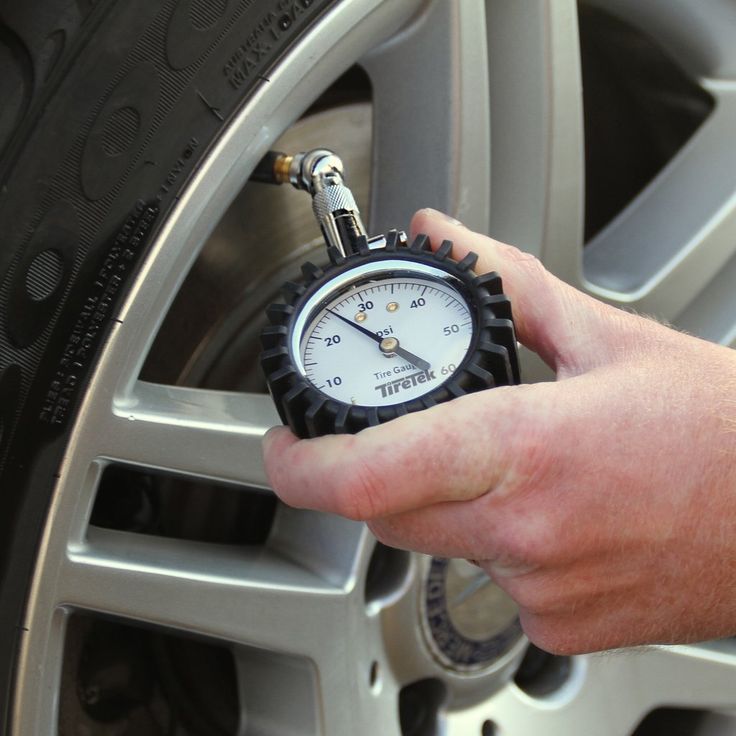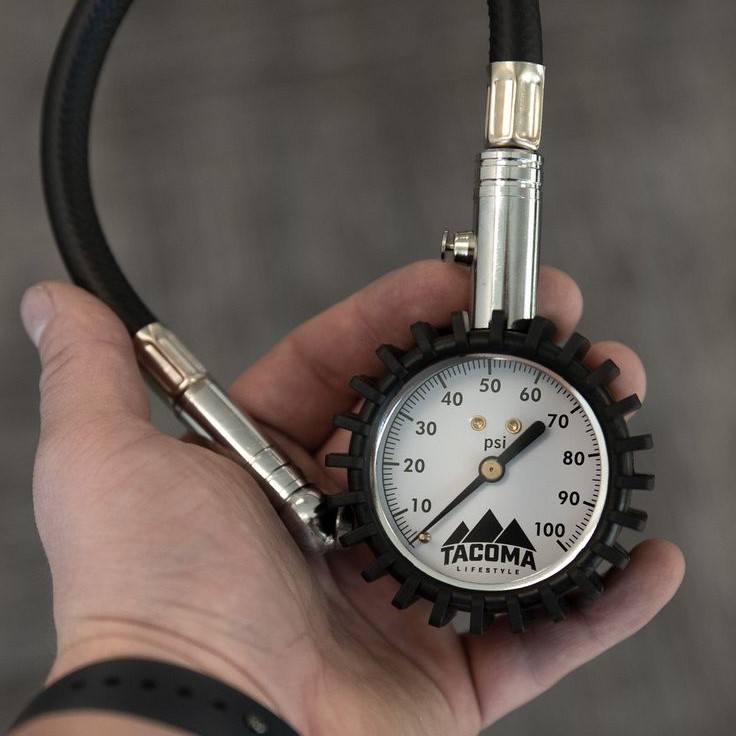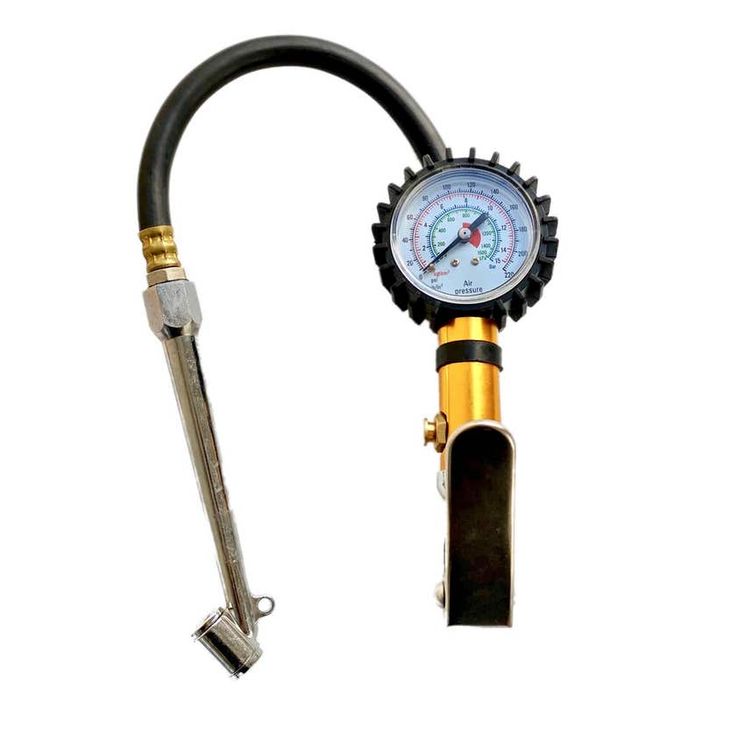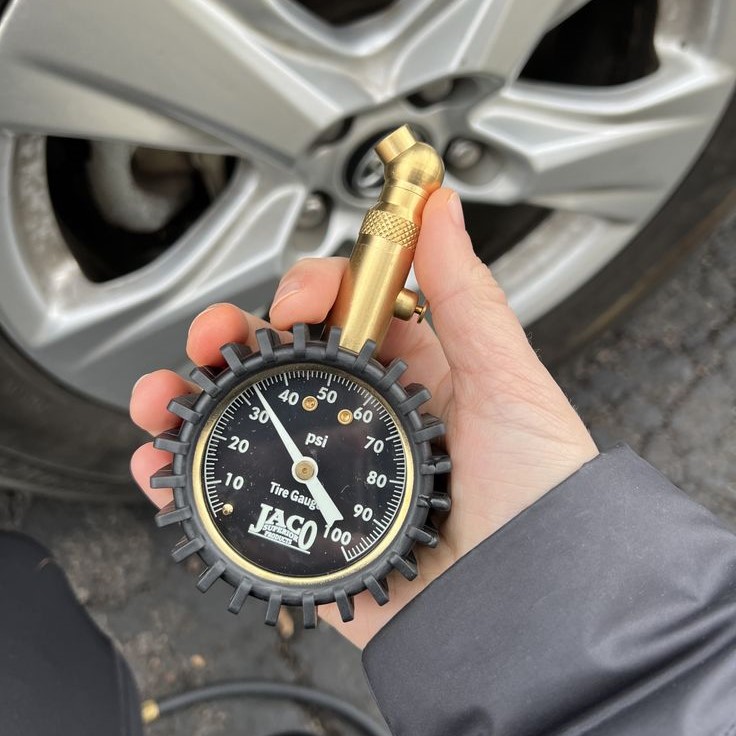Importance of Correct Tire Pressure
How to use a tire pressure gauge? Maintaining the correct tire pressure is crucial for your vehicle. It ensures safety, enhances fuel efficiency, and prolongs tire life. Incorrect tire pressure can lead to various issues. Over-inflated tires may result in a rough ride and uneven tire wear. Under-inflated tires can cause poor fuel economy and handling. They can also overheat, increasing the risk of a blowout. Proper tire pressure contributes to optimal vehicle performance. It provides better traction and braking capabilities. This is vital for safety, especially in harsh weather conditions. Regular checks can prevent premature tire wear. This saves money on early replacements.
Also, correct tire pressure supports the environment. It reduces CO2 emissions by improving fuel consumption. Every driver should know how to use a tire pressure gauge. This skill helps maintain tire pressure at the manufacturer’s recommended level. It is a simple yet impactful way to care for your car and driving experience.

Types of Tire Pressure Gauges
Choosing the right tire pressure gauge can improve your tire maintenance routine. There are several types to consider, each with its pros and cons.
Analog Dial Gauges
Analog dial gauges have a simple, clock-like face. They display the pressure with a needle. These gauges are easy to read and don’t require batteries. However, they are not as precise as digital gauges.
Digital Gauges
Digital gauges have an LCD display that shows the tire pressure reading. They are accurate and easy to read, even in low light. These require batteries to operate.
Stick (Pencil) Gauges
Stick gauges are compact and resemble a pen, which makes them easy to carry. They show pressure by extending a measuring rod. While handy, they can be less accurate than dial or digital gauges.
Programmable Gauges
Programmable gauges allow you to set the target pressure for your tires. They can beep or flash when the correct pressure is reached. These are great for ensuring consistency but are usually more expensive.
When deciding how to use a tire pressure gauge, choose one that fits your needs and budget. Remember to check its compatibility with your vehicle’s tire valve and consider features like accuracy, ease of use, and durability when making your decision.
How to Properly Use a Tire Pressure Gauge
Using a tire pressure gauge correctly is essential for accurate readings. Here’s how to do it:
- Remove the Valve Cap: Start by taking the cap off the tire’s valve stem.
- Press the Gauge Against the Valve Stem: Place the tire pressure gauge onto the valve stem. Push down firmly to ensure a good seal. This will prevent air from escaping.
- Read the Pressure: For analog gauges, read the pressure where the needle stops. On digital gauges, wait for the reading to stabilize on the display.
- Repeat if Necessary: If you’re unsure, remove the gauge and reset it. Press it onto the valve stem again for a second reading.
- Replace the Valve Cap: After checking, always put the valve cap back on to keep debris out.
Do these steps quickly to avoid losing too much air from the tire. With regular practice, you’ll learn how to use a tire pressure gauge with ease and precision.

Step-by-Step Guide to Checking Your Tire Pressure
Checking your tire pressure is a simple process. Follow this guide to ensure accuracy:
- Find the Correct Pressure: Your vehicle’s ideal tire pressure is in the owner’s manual or on a sticker in the door jamb.
- Ensure Tires are Cold: For the most accurate reading, check your tires when they are cold. This means the car has been parked for at least three hours or has been driven less than a mile.
- Remove the Cap from the Valve Stem: Unscrew the cap from the air valve on the tire. Keep it in a safe place to avoid losing it.
- Place the Gauge on the Valve Stem: Put the tire pressure gauge onto the valve stem. Push firmly to seal and prevent air from escaping.
- Take the Reading: Look at the pressure gauge and note the reading. For stick gauges, read where the measuring rod stops. With dial or digital gauges, check the dial or screen.
- Compare to Recommended Pressure: See if the tire pressure matches the manufacturer’s recommendations. If not, adjust by adding or releasing air.
- Check All Tires: Repeat the process for all tires, including the spare.
- Replace Valve Caps: Once done, screw the valve caps back on to all tires.
Regularly doing these steps will help you maintain the correct tire pressure. It takes only a few minutes but can greatly influence your vehicle’s performance and safety. Remember to learn how to use a tire pressure gauge properly for the best results.
Troubleshooting Common Tire Pressure Gauge Issues
Even the best tools can face issues, and tire pressure gauges are no exception. Understanding common problems and knowing how to resolve them is a key part of maintaining your vehicle’s tire pressure. Here are some troubleshooting tips to keep your tire pressure gauge in working order:

Inaccurate Readings
Inaccurate readings can result from several factors:
- Check for Dirt: Dirt or debris in the gauge can give wrong readings. Clean the gauge regularly to avoid this.
- Examine the Seal: A poor seal on the valve stem can cause air to escape. Ensure the gauge is seated correctly.
- Batteries: For digital gauges, weakened batteries can lead to inaccuracies. Replace them as needed.
- Zeroing: Analog gauges may need zeroing before use. Check that the needle rests at zero when not in use.
Gauge Does Not Register
If your gauge doesn’t register any pressure:
- Check Compatibility: Make sure the gauge fits the valve stem of your tires.
- Inspect for Damage: A damaged gauge won’t function. Look for any visible signs of wear or breakage.
Fluctuating Readings
Unreliable readings can be caused by:
- Consistent Pressure: Apply consistent pressure when fitting the gauge to avoid fluctuations.
- Quick Checks: Rapid checking loses air and causes varying readings. Be steady and deliberate.
Air Leakage
To deal with air leakage:
- Check the Seal: Ensure the gauge creates a tight seal with the valve stem.
- Push Firmly: Apply a firm, even pressure to the gauge to prevent air from leaking out.
By addressing these issues, you can maintain tire pressure accurately. Keeping your gauge clean, properly stored, and regularly checked for damage ensures reliable performance. And always remember to learn how to use a tire pressure gauge correctly for the most precise tire maintenance.
Maintaining Your Tire Pressure Gauge for Accuracy
To ensure your tire pressure gauge delivers accurate results, regular maintenance is key. Here are simple steps to keep your gauge in top shape:
Clean Regularly
- Wipe After Use: After each use, take a moment to wipe your gauge with a clean, dry cloth. This helps remove any dirt, dust, or grease that may have accumulated during the measurement process.
- Prevent Dirt Buildup: Regular cleaning helps prevent dirt buildup, which can interfere with the gauge’s accuracy. A dirty gauge may provide misleading readings, potentially resulting in under-inflated or over-inflated tires.
- Use a Safe Cleaning Method: If necessary, use a mild soap and water solution to clean the gauge, but ensure it is completely dry before storing it. Avoid harsh chemicals that can damage the gauge materials.
Store Properly
- Safe Storage Location: Always store your tire pressure gauge in a safe, dry place. Consider keeping it in your glove compartment or a dedicated tool storage area in your vehicle to prevent it from getting lost.
- Avoid Moisture Exposure: Moisture can lead to rust or damage in both analog and digital gauges. Keeping it in a dry environment helps prolong its lifespan and maintain its accuracy.
- Impact Protection: Store your gauge in a protective case or pouch when not in use to shield it from physical impacts. This is particularly important if the gauge uses electronic components, which can be sensitive to drops.
Check for Wear
- Visual Inspections: Regularly examine your gauge for any signs of wear, such as frayed hoses, cracks in the casing, or issues with the display (in digital gauges). Addressing wear early can prevent further damage.
- Signs of Damage: If you notice any visible damage, such as bending or poor functionality, do not attempt to continue using the gauge as it may not provide accurate readings.
- When to Replace: If your gauge shows signs of damage or consistently gives inaccurate readings, it’s time to replace it. Investing in a new gauge can ensure accurate tire pressure monitoring, enhancing your vehicle safety.
Test for Accuracy
- Compare Readings: Occasionally test your tire pressure gauge against another reliable gauge to check for accuracy. This can help determine whether your gauge is still providing consistent pressure readings.
- Frequency of Testing: Consider testing your gauge at least every few months or before important trips. Regular accuracy checks are vital for ensuring that you maintain optimal tire pressure.
- Calibration Maintenance: If you use a digital gauge, consult the manufacturer’s instructions regarding calibration to confirm that your readings remain accurate over time.
Handle with Care
- Gentle Usage: When using your tire pressure gauge, always be gentle. Avoid applying excessive force when attaching it to the valve stem, as this can lead to malfunctions or breakage.
- Avoid Dropping: Take care not to drop or knock your gauge against hard surfaces. Rough handling can damage mechanical components or impact the calibration, leading to inaccurate readings.
- Follow Manufacturer Guidelines: Adhere to any specific handling instructions provided by the gauge manufacturer. This will ensure you maintain its functionality and accuracy over its operational lifespan.
By following these maintenance tips, your ability to determine how to use a tire pressure gauge will be backed by the confidence that your tool is precise. This attention to care helps extend the life of the gauge and keeps your tire pressure checks reliable, contributing to your vehicle’s safety and efficiency.
When to Check Your Tire Pressure
Knowing when to check your tire pressure is as important as knowing how to use a tire pressure gauge. It’s best to check your tire pressure under specific conditions to get the most accurate readings. Here’s when you should perform this essential maintenance task:
- Check Monthly: At a minimum, check your tire pressure once a month. Tires can lose air over time, even without leaks.
- Before Long Trips: Before you hit the road for a lengthy journey, make sure your tires are properly inflated. This can improve safety and fuel economy.
- With Seasonal Changes: Temperature changes can affect tire pressure. Check it as the seasons change, especially during extreme heat or cold.
- After a Tire Repair: If you’ve had a tire repaired or replaced, check the pressure. The process could alter its inflation.
- If You Notice a Change: If your vehicle handles differently, or you notice irregular tire wear, check the pressure immediately.
By checking your tire pressure routinely and in these situations, you help ensure safe and efficient driving. Quick checks prevent issues and keep you informed about the state of your tires.
Understanding Tire Pressure Gauge Readings
To maintain proper tire pressure, you must understand tire pressure gauge readings. Here’s how to interpret them:
PSI: Pounds per Square Inch
- Definition: PSI stands for Pounds per Square Inch. It is the most commonly used unit of measure for tire pressure in the United States and many other countries.
- Usage: Tire manufacturers recommend specific PSI levels for their tires to ensure optimal performance, safety, and fuel efficiency.
- Importance: Maintaining the correct PSI in your tires is vital because under-inflated or over-inflated tires can lead to poor handling, increased tire wear, and reduced fuel efficiency. Checking and adjusting your tire pressure regularly helps maintain vehicle safety.
Bar: Alternative Pressure Measurement
- Definition: The bar is another unit of pressure that some tire pressure gauges use. It is based on the atmospheric pressure at sea level.
- Conversion to PSI: One bar is equivalent to approximately 14.5 PSI. This means that if your tire pressure gauge displays a reading of 2 bars, you can convert it to PSI by multiplying by 14.5, resulting in about 29 PSI.
- Global Usage: The bar is commonly used in many European countries and scientific contexts. Understanding this unit is useful for drivers who travel internationally or use equipment measured in bars.
KPa: Kilopascal
- Definition: KPa, or kilopascal, is another unit of pressure often seen on tire pressure gauges, particularly in countries that use the metric system.
- Conversion to PSI: To convert kilopascals to PSI, you divide the kPa value by 6.895. For example, if your tire pressure reads 240 kPa, dividing by 6.895 would give you approximately 34.8 PSI.
- Significance: Knowing how to convert KPa to PSI is important for those using tire pressure data in various settings, ensuring accurate readings regardless of the unit.
Summary of Measurement Units
- PSI: Commonly used in the U.S. and crucial for checking tire pressure.
- Bar: An alternative measurement, particularly in Europe, with one bar equating to about 14.5 PSI.
- KPa: A metric measurement that requires conversion to PSI by dividing by 6.895, useful for global tire maintenance standards.
After you check your tire pressure, compare the reading to the recommended level found in your vehicle’s owner’s manual or door jamb sticker. If the tire pressure is below the recommendation, you need to add air. If it’s higher, let some air out.
Remember, variations in temperature can affect tire pressure. For every 10 degrees Fahrenheit change in temperature, tire pressure can change about 1 PSI. So, always account for the current temperature when reading your tire pressure gauge.
Understanding these readings and taking temperature into account helps ensure you maintain the correct tire pressure. This contributes to vehicle safety, efficiency, and the longevity of your tires. Keep practicing how to use a tire pressure gauge for the best results over time.

